Project Management Methodologies: Agile and Waterfall in the PLC
VerifiedAdded on 2023/06/10
|6
|1227
|177
Essay
AI Summary
This essay provides a comprehensive overview of project management methodologies, focusing on a detailed comparison between the Agile and Waterfall approaches. It begins by defining methodology and its role in project management, then delves into the specifics of Agile and Waterfall, highlighting their benefits, drawbacks, and key differences. The essay further explores how each methodology relates to the project life cycle, illustrating their respective applications in software development and project management. It references various sources and provides a structured analysis suitable for understanding the practical implications of choosing between Agile and Waterfall methodologies in different project scenarios. Desklib offers a wide range of past papers and solved assignments to aid students in their studies.
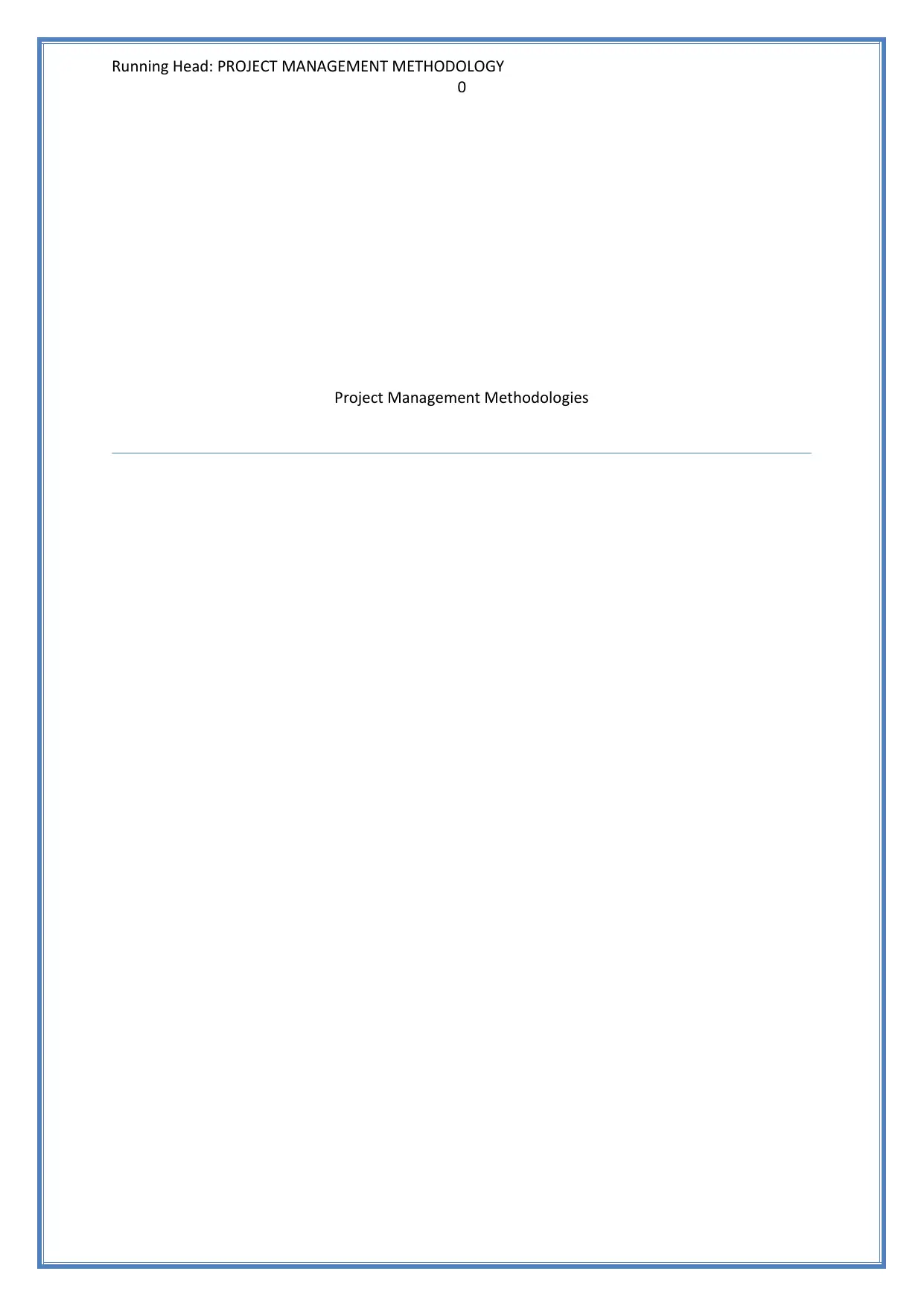
Running Head: PROJECT MANAGEMENT METHODOLOGY
0
Project Management Methodologies
0
Project Management Methodologies
Paraphrase This Document
Need a fresh take? Get an instant paraphrase of this document with our AI Paraphraser
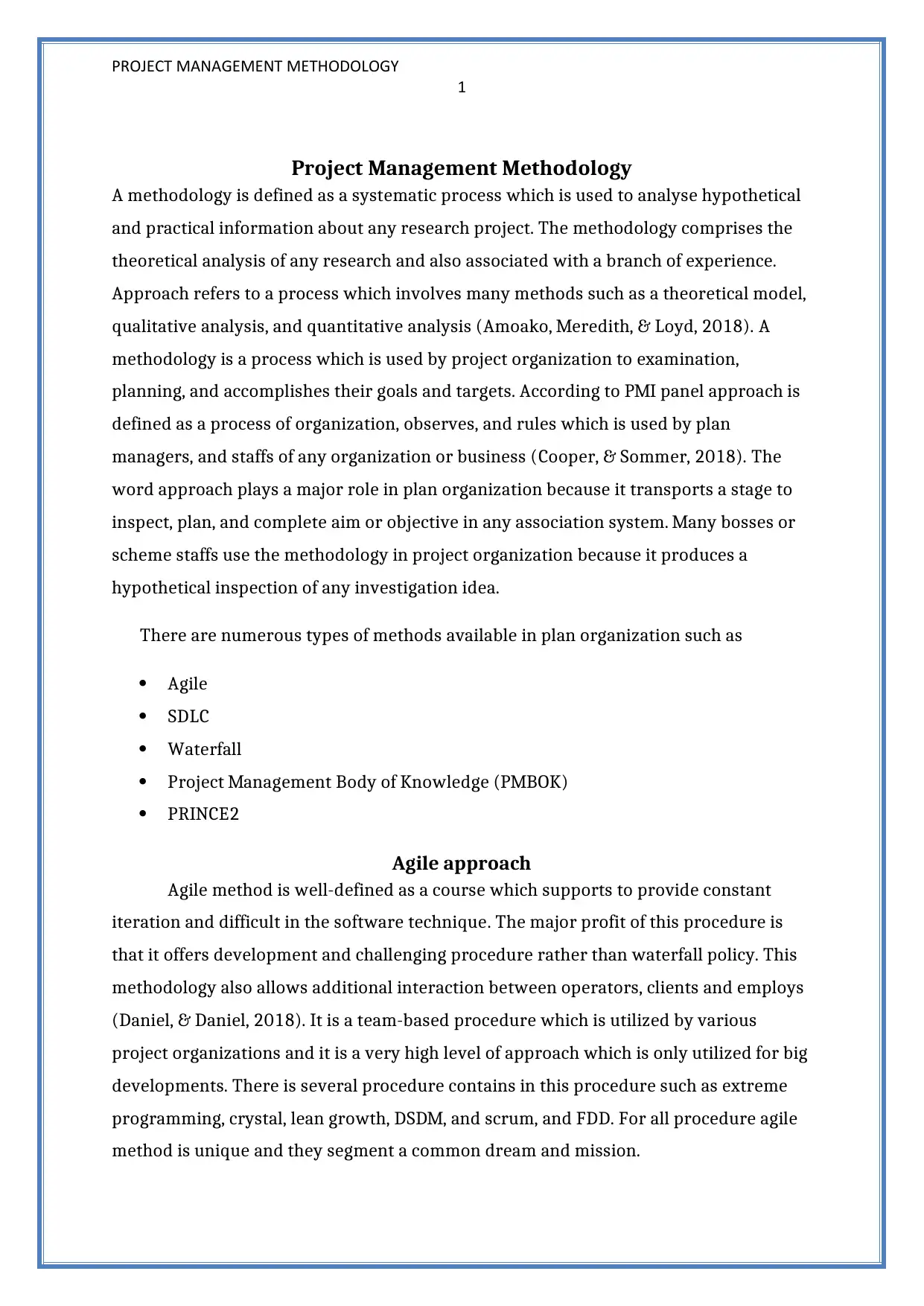
PROJECT MANAGEMENT METHODOLOGY
1
Project Management Methodology
A methodology is defined as a systematic process which is used to analyse hypothetical
and practical information about any research project. The methodology comprises the
theoretical analysis of any research and also associated with a branch of experience.
Approach refers to a process which involves many methods such as a theoretical model,
qualitative analysis, and quantitative analysis (Amoako, Meredith, & Loyd, 2018). A
methodology is a process which is used by project organization to examination,
planning, and accomplishes their goals and targets. According to PMI panel approach is
defined as a process of organization, observes, and rules which is used by plan
managers, and staffs of any organization or business (Cooper, & Sommer, 2018). The
word approach plays a major role in plan organization because it transports a stage to
inspect, plan, and complete aim or objective in any association system. Many bosses or
scheme staffs use the methodology in project organization because it produces a
hypothetical inspection of any investigation idea.
There are numerous types of methods available in plan organization such as
Agile
SDLC
Waterfall
Project Management Body of Knowledge (PMBOK)
PRINCE2
Agile approach
Agile method is well-defined as a course which supports to provide constant
iteration and difficult in the software technique. The major profit of this procedure is
that it offers development and challenging procedure rather than waterfall policy. This
methodology also allows additional interaction between operators, clients and employs
(Daniel, & Daniel, 2018). It is a team-based procedure which is utilized by various
project organizations and it is a very high level of approach which is only utilized for big
developments. There is several procedure contains in this procedure such as extreme
programming, crystal, lean growth, DSDM, and scrum, and FDD. For all procedure agile
method is unique and they segment a common dream and mission.
1
Project Management Methodology
A methodology is defined as a systematic process which is used to analyse hypothetical
and practical information about any research project. The methodology comprises the
theoretical analysis of any research and also associated with a branch of experience.
Approach refers to a process which involves many methods such as a theoretical model,
qualitative analysis, and quantitative analysis (Amoako, Meredith, & Loyd, 2018). A
methodology is a process which is used by project organization to examination,
planning, and accomplishes their goals and targets. According to PMI panel approach is
defined as a process of organization, observes, and rules which is used by plan
managers, and staffs of any organization or business (Cooper, & Sommer, 2018). The
word approach plays a major role in plan organization because it transports a stage to
inspect, plan, and complete aim or objective in any association system. Many bosses or
scheme staffs use the methodology in project organization because it produces a
hypothetical inspection of any investigation idea.
There are numerous types of methods available in plan organization such as
Agile
SDLC
Waterfall
Project Management Body of Knowledge (PMBOK)
PRINCE2
Agile approach
Agile method is well-defined as a course which supports to provide constant
iteration and difficult in the software technique. The major profit of this procedure is
that it offers development and challenging procedure rather than waterfall policy. This
methodology also allows additional interaction between operators, clients and employs
(Daniel, & Daniel, 2018). It is a team-based procedure which is utilized by various
project organizations and it is a very high level of approach which is only utilized for big
developments. There is several procedure contains in this procedure such as extreme
programming, crystal, lean growth, DSDM, and scrum, and FDD. For all procedure agile
method is unique and they segment a common dream and mission.
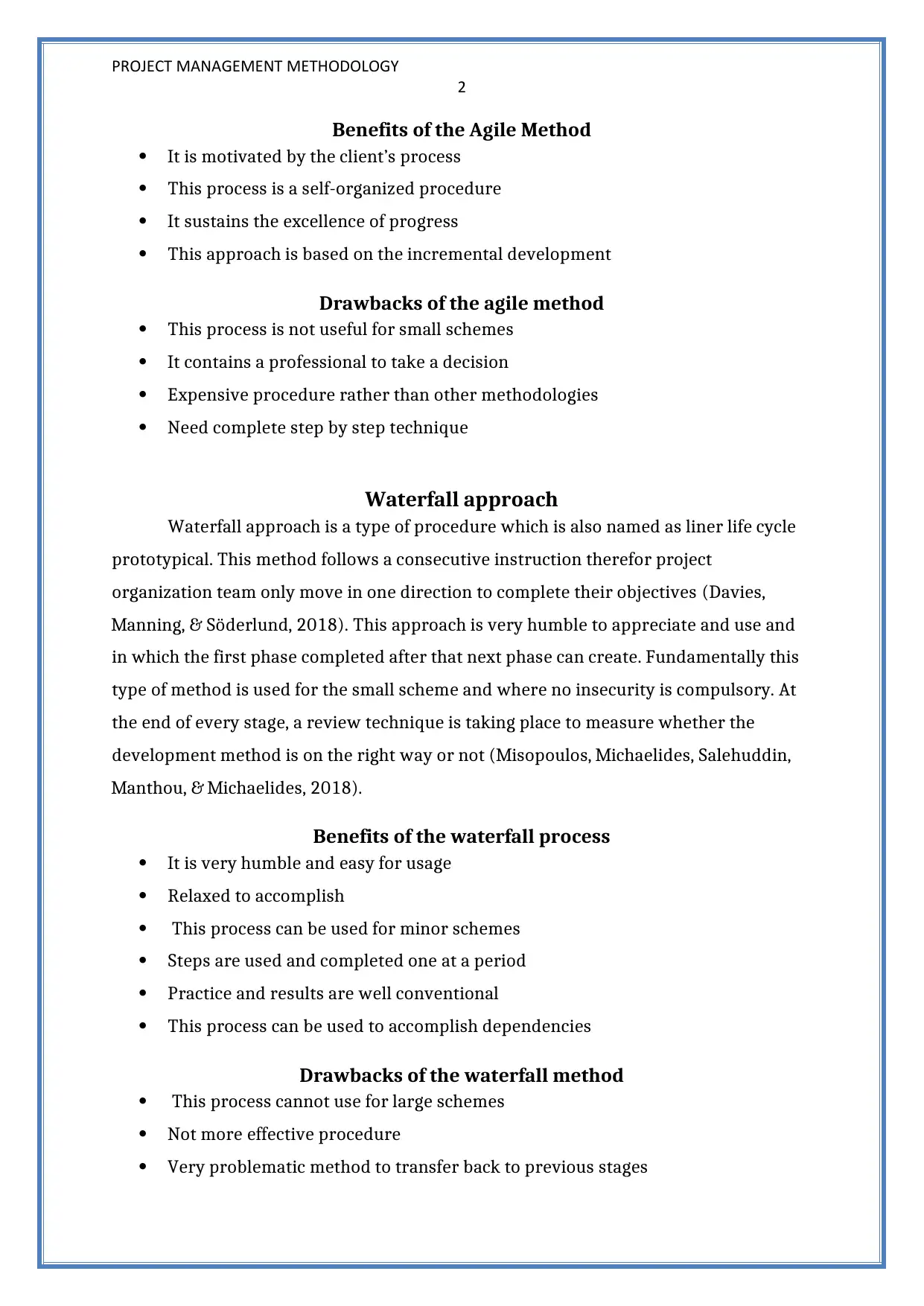
PROJECT MANAGEMENT METHODOLOGY
2
Benefits of the Agile Method
It is motivated by the client’s process
This process is a self-organized procedure
It sustains the excellence of progress
This approach is based on the incremental development
Drawbacks of the agile method
This process is not useful for small schemes
It contains a professional to take a decision
Expensive procedure rather than other methodologies
Need complete step by step technique
Waterfall approach
Waterfall approach is a type of procedure which is also named as liner life cycle
prototypical. This method follows a consecutive instruction therefor project
organization team only move in one direction to complete their objectives (Davies,
Manning, & Söderlund, 2018). This approach is very humble to appreciate and use and
in which the first phase completed after that next phase can create. Fundamentally this
type of method is used for the small scheme and where no insecurity is compulsory. At
the end of every stage, a review technique is taking place to measure whether the
development method is on the right way or not (Misopoulos, Michaelides, Salehuddin,
Manthou, & Michaelides, 2018).
Benefits of the waterfall process
It is very humble and easy for usage
Relaxed to accomplish
This process can be used for minor schemes
Steps are used and completed one at a period
Practice and results are well conventional
This process can be used to accomplish dependencies
Drawbacks of the waterfall method
This process cannot use for large schemes
Not more effective procedure
Very problematic method to transfer back to previous stages
2
Benefits of the Agile Method
It is motivated by the client’s process
This process is a self-organized procedure
It sustains the excellence of progress
This approach is based on the incremental development
Drawbacks of the agile method
This process is not useful for small schemes
It contains a professional to take a decision
Expensive procedure rather than other methodologies
Need complete step by step technique
Waterfall approach
Waterfall approach is a type of procedure which is also named as liner life cycle
prototypical. This method follows a consecutive instruction therefor project
organization team only move in one direction to complete their objectives (Davies,
Manning, & Söderlund, 2018). This approach is very humble to appreciate and use and
in which the first phase completed after that next phase can create. Fundamentally this
type of method is used for the small scheme and where no insecurity is compulsory. At
the end of every stage, a review technique is taking place to measure whether the
development method is on the right way or not (Misopoulos, Michaelides, Salehuddin,
Manthou, & Michaelides, 2018).
Benefits of the waterfall process
It is very humble and easy for usage
Relaxed to accomplish
This process can be used for minor schemes
Steps are used and completed one at a period
Practice and results are well conventional
This process can be used to accomplish dependencies
Drawbacks of the waterfall method
This process cannot use for large schemes
Not more effective procedure
Very problematic method to transfer back to previous stages
⊘ This is a preview!⊘
Do you want full access?
Subscribe today to unlock all pages.

Trusted by 1+ million students worldwide
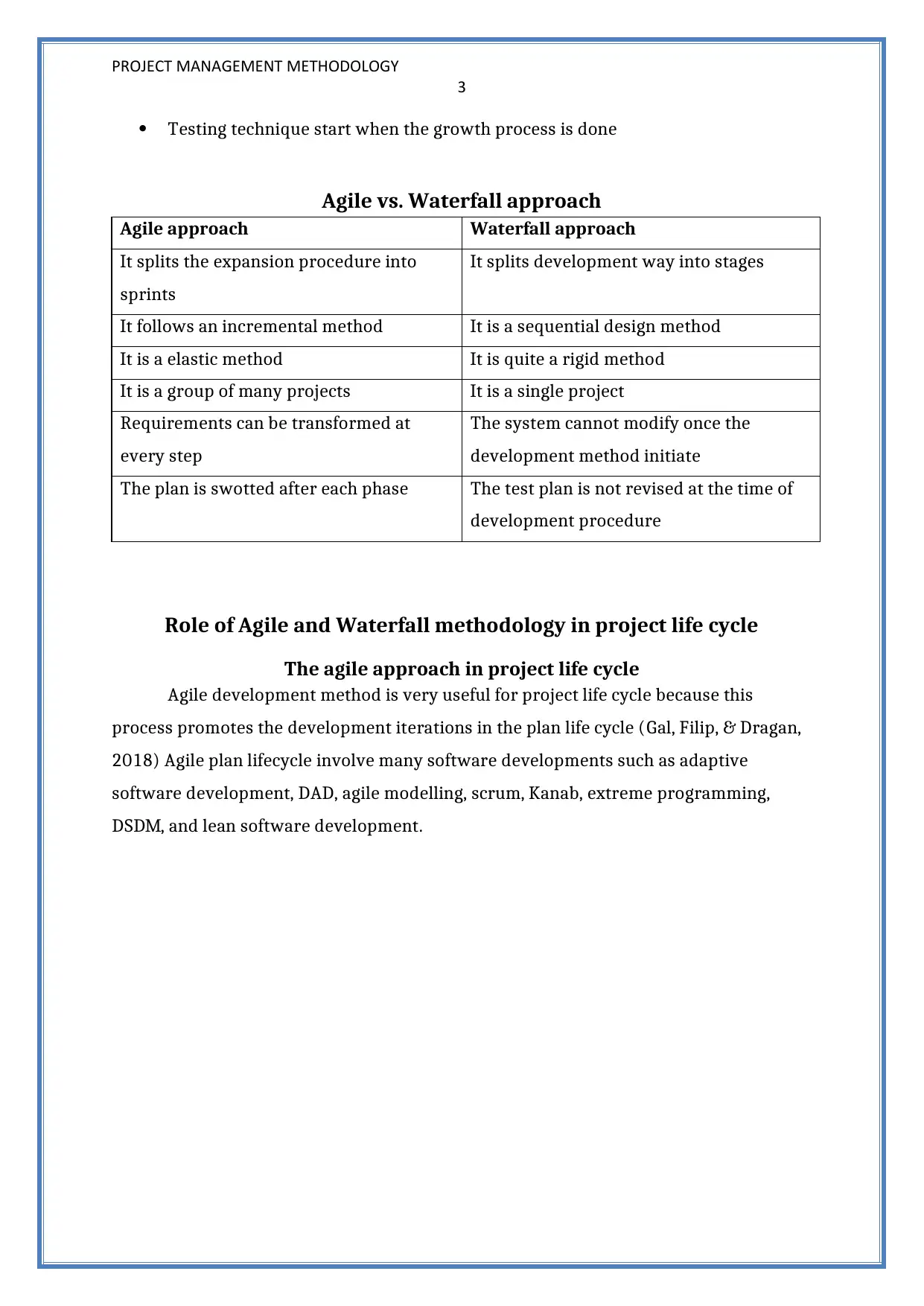
PROJECT MANAGEMENT METHODOLOGY
3
Testing technique start when the growth process is done
Agile vs. Waterfall approach
Agile approach Waterfall approach
It splits the expansion procedure into
sprints
It splits development way into stages
It follows an incremental method It is a sequential design method
It is a elastic method It is quite a rigid method
It is a group of many projects It is a single project
Requirements can be transformed at
every step
The system cannot modify once the
development method initiate
The plan is swotted after each phase The test plan is not revised at the time of
development procedure
Role of Agile and Waterfall methodology in project life cycle
The agile approach in project life cycle
Agile development method is very useful for project life cycle because this
process promotes the development iterations in the plan life cycle (Gal, Filip, & Dragan,
2018) Agile plan lifecycle involve many software developments such as adaptive
software development, DAD, agile modelling, scrum, Kanab, extreme programming,
DSDM, and lean software development.
3
Testing technique start when the growth process is done
Agile vs. Waterfall approach
Agile approach Waterfall approach
It splits the expansion procedure into
sprints
It splits development way into stages
It follows an incremental method It is a sequential design method
It is a elastic method It is quite a rigid method
It is a group of many projects It is a single project
Requirements can be transformed at
every step
The system cannot modify once the
development method initiate
The plan is swotted after each phase The test plan is not revised at the time of
development procedure
Role of Agile and Waterfall methodology in project life cycle
The agile approach in project life cycle
Agile development method is very useful for project life cycle because this
process promotes the development iterations in the plan life cycle (Gal, Filip, & Dragan,
2018) Agile plan lifecycle involve many software developments such as adaptive
software development, DAD, agile modelling, scrum, Kanab, extreme programming,
DSDM, and lean software development.
Paraphrase This Document
Need a fresh take? Get an instant paraphrase of this document with our AI Paraphraser
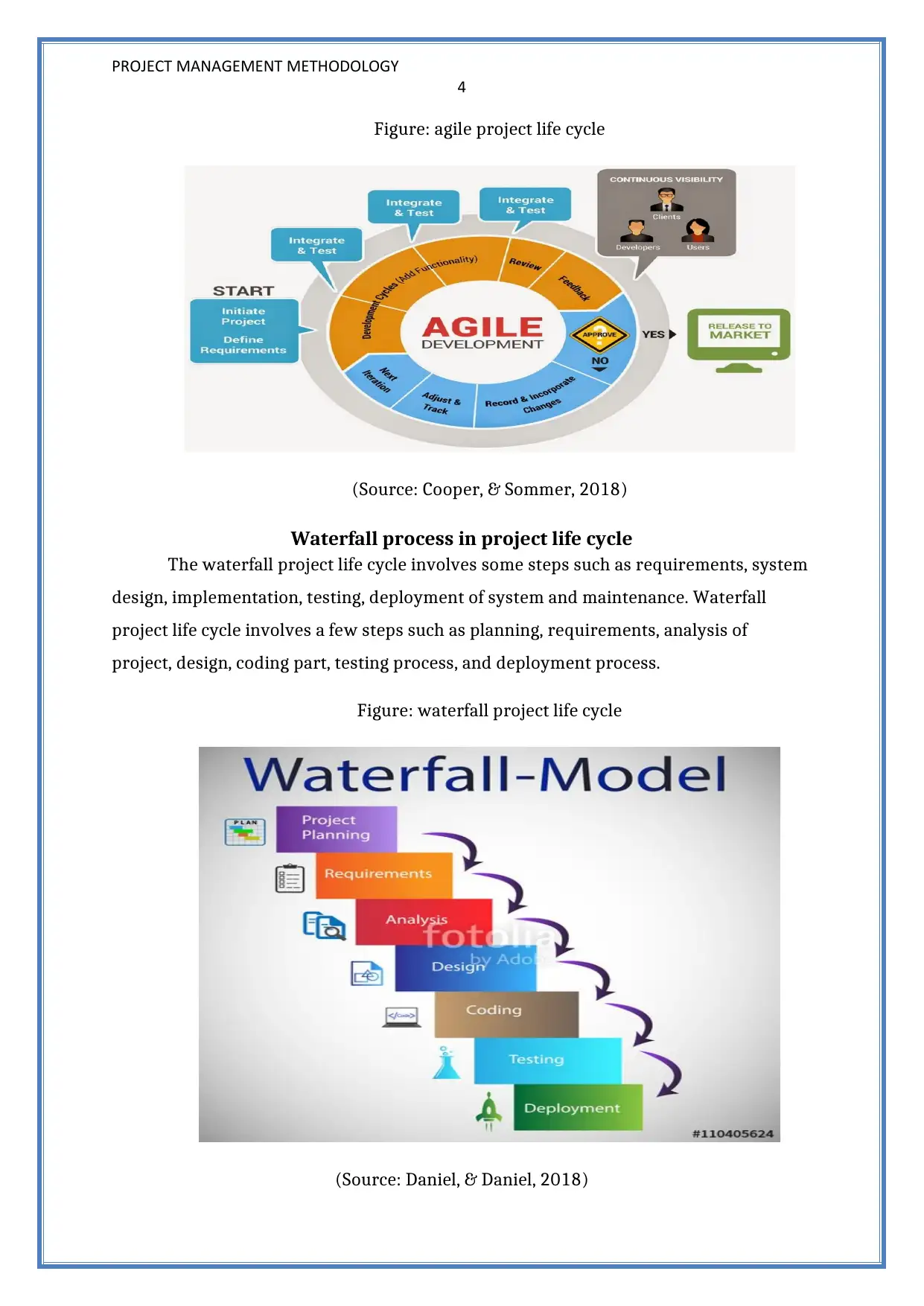
PROJECT MANAGEMENT METHODOLOGY
4
Figure: agile project life cycle
(Source: Cooper, & Sommer, 2018)
Waterfall process in project life cycle
The waterfall project life cycle involves some steps such as requirements, system
design, implementation, testing, deployment of system and maintenance. Waterfall
project life cycle involves a few steps such as planning, requirements, analysis of
project, design, coding part, testing process, and deployment process.
Figure: waterfall project life cycle
(Source: Daniel, & Daniel, 2018)
4
Figure: agile project life cycle
(Source: Cooper, & Sommer, 2018)
Waterfall process in project life cycle
The waterfall project life cycle involves some steps such as requirements, system
design, implementation, testing, deployment of system and maintenance. Waterfall
project life cycle involves a few steps such as planning, requirements, analysis of
project, design, coding part, testing process, and deployment process.
Figure: waterfall project life cycle
(Source: Daniel, & Daniel, 2018)

PROJECT MANAGEMENT METHODOLOGY
5
References
Amoako, K., Meredith, J., & Loyd, K. W. (2018). Using a social capital lens to identify the
mechanisms of top management commitment: a case study of a technology
project. Project Management Journal, 49(1), 79-95.
Cooper, R. G., & Sommer, A. F. (2018). Agile–Stage-Gate for Manufacturers: Changing the
Way New Products Are Developed Integrating Agile project management
methods into a Stage-Gate system offers both opportunities and
challenges. Research-Technology Management, 61(2), 17-26.
Daniel, P. A., & Daniel, C. (2018). Complexity, uncertainty and mental models: From a
paradigm of regulation to a paradigm of emergence in project
management. International Journal of Project Management, 36(1), 184-197.
Davies, A., Manning, S., & Söderlund, J. (2018). When neighboring disciplines fail to learn
from each other: The case of innovation and project management
research. Research Policy, 47(5), 965-979.
Gal, A., Filip, I., & Dragan, F. (2018). A New Vision Over Agile Project Management in the
Internet of Things Era. Procedia-Social and Behavioral Sciences, 238, 277-285.
Misopoulos, F., Michaelides, R., Salehuddin, M. A., Manthou, V., & Michaelides, Z. (2018).
Addressing Organisational Pressures as Drivers towards Sustainability in
Manufacturing Projects and Project Management
Methodologies. Sustainability, 10(6), 2098.
5
References
Amoako, K., Meredith, J., & Loyd, K. W. (2018). Using a social capital lens to identify the
mechanisms of top management commitment: a case study of a technology
project. Project Management Journal, 49(1), 79-95.
Cooper, R. G., & Sommer, A. F. (2018). Agile–Stage-Gate for Manufacturers: Changing the
Way New Products Are Developed Integrating Agile project management
methods into a Stage-Gate system offers both opportunities and
challenges. Research-Technology Management, 61(2), 17-26.
Daniel, P. A., & Daniel, C. (2018). Complexity, uncertainty and mental models: From a
paradigm of regulation to a paradigm of emergence in project
management. International Journal of Project Management, 36(1), 184-197.
Davies, A., Manning, S., & Söderlund, J. (2018). When neighboring disciplines fail to learn
from each other: The case of innovation and project management
research. Research Policy, 47(5), 965-979.
Gal, A., Filip, I., & Dragan, F. (2018). A New Vision Over Agile Project Management in the
Internet of Things Era. Procedia-Social and Behavioral Sciences, 238, 277-285.
Misopoulos, F., Michaelides, R., Salehuddin, M. A., Manthou, V., & Michaelides, Z. (2018).
Addressing Organisational Pressures as Drivers towards Sustainability in
Manufacturing Projects and Project Management
Methodologies. Sustainability, 10(6), 2098.
⊘ This is a preview!⊘
Do you want full access?
Subscribe today to unlock all pages.

Trusted by 1+ million students worldwide
1 out of 6
Related Documents
Your All-in-One AI-Powered Toolkit for Academic Success.
+13062052269
info@desklib.com
Available 24*7 on WhatsApp / Email
![[object Object]](/_next/static/media/star-bottom.7253800d.svg)
Unlock your academic potential
Copyright © 2020–2025 A2Z Services. All Rights Reserved. Developed and managed by ZUCOL.
